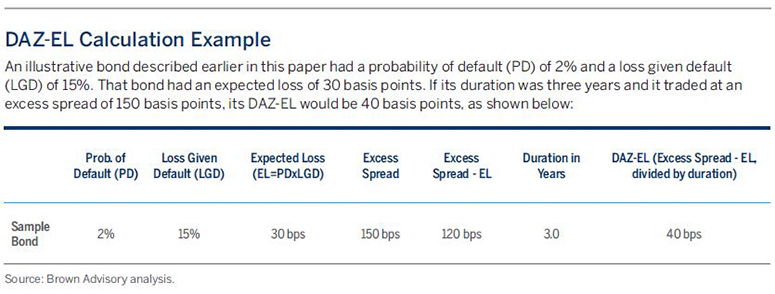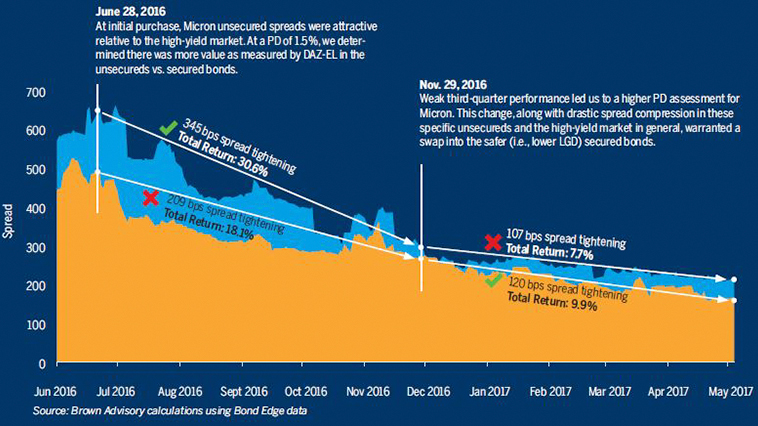A credit investor’s success rests on the strength of his or her credit research and ability to translate that research into smart capital allocation decisions about individually attractive bonds. That may sound like an obvious point, but fixed income portfolios are not always guided by that principle—some are guided more by an effort to conform to a benchmark index, while others focus on driving returns with bets on portfolio duration or other factors.
We believe Brown Advisory’s approach can lead to compelling results over time, but it requires a disciplined framework for credit research. Specifically, we need to understand why a bond is priced the way it is—improper reading of a business risk? Sentiment about the sector? Rate sensitivity?—before we can judge whether its price is reasonable or attractive.
DAZ-EL: Taking the Guesswork Out of Pricing Credit Risk
Pricing credit risk effectively is particularly important in today’s market. Credit spreads are pushing historical tights, neither underperformance nor transaction activity is having much effect on pricing, and the spread premium of high-yield over investment-grade bonds continues to erode. In short, the market is not heavily discriminating between levels of risk, making it all the more difficult to discern between good and bad value.
Avoiding these value traps is what separates average managers from great ones, and to do so requires a bit of “practical pessimism.” We need to understand the worst-case scenarios for the bonds we buy—but assessing risk is one thing, and translating that risk into an objective assessment of value is another.
Brown Advisory’s DAZ-EL calculation process (short for “duration-adjusted z-spread minus expected loss”) is vital to our efforts for three reasons.
- It is a standardized framework. The DAZ-EL process lets us evaluate and objectively compare bonds across sectors with varying maturities and credit quality—all using a single metric.
- It helps us translate risk into a quantifiable statistic. With this process, we distill historical and projected financial, strategic and qualitative issues into a single statistic.This keeps our decision making objective and prevents us from making gut calls about risk-reward dynamics in a given situation.
- It integrates our credit research with our risk management and portfolio decisions. As DAZ-EL standardizes the decision process, its output forces us to allocate capital to those sectors and asset classes that offer the best risk-adjusted returns, and helps prevent overexposure to any particular risk.
Ultimately, the framework aims to help us consistently choose attractive bonds for our client portfolios. For any manager, long-term outperformance is based on being right more often than wrong (and on being right more often than the competition). We believe that the DAZ-EL process is the best way for us to maximize the number of good decisions we make over time.
How It Works
Credit risk assessment focuses on two classically accepted components.
- Probability of default (“PD”) refers to the likelihood that an issuer under stress would fail to meet its debt obligations or breach its covenants, prompting a bankruptcy filing.
- Loss given default (“LGD”) refers to the likely percentage of principal at risk in a default scenario.
The multiplication of these two statistics produces an expected loss (the “EL” in DAZ-EL). For example, if a bond has a 2% PD (i.e., a 2% chance of defaulting) and a 15% LGD (i.e., a likely 15% of principal in a default), investors should “expect” a loss of 2% x 15% = 0.30%, or 30 basis points of their investment, as a midpoint assumption of all reasonably likely outcomes.
This concept is widely applied in the fixed income world. However, deriving PD and LGD consistently and accurately is where we seek to truly add value in our credit research process.
Probability of default: Using 30 years of historical default data, we use a number of factors—four quantitative and 15 qualitative factors in all—to calculate PD. These include:
- Liquidity: Companies with stronger liquidity are typically better able to service debt obligations during periods of stress. Because capital structures and leverage ratios vary by sector, we pay close attention to interest and fixed charge coverage metrics, which help normalize our assessment across sectors.
- Levered free cash flow to debt: Add-backs and accounting adjustments found in reported results can often cloud a firm’s real financial situation. To project “true” cash flow relative to debt, we carefully analyze historical performance and build data-driven hypotheses about expected capital expenditures (another metric that varies by sector).
- Refinanceability: For any successful business operation, maintaining a healthy balance sheet is paramount, and that involves the ability to reliably refinance maturing debt or raise new capital. We assess a company’s ability to do so by weighing market interest rates for comparable issuers against the company’s near-term obligations, contingent liabilities, cash flow generation and equity cushion.
- Volatility of cash flows: We further test an issuer’s ability to service its capital structure in times of stress by gauging the health of the issuer’s sector, that sector’s inherent cyclicality and how sector participants have performed historically during recessions.
Loss Given Default: LGD is derived using a “bankruptcy waterfall” analysis. We estimate losses within a modeled default scenario, taking into consideration corporate structure, relative priority of a given bond within the capital structure, indenture restrictions and precedent restructuring multiples. All investments across the quality spectrum go through this analysis, ensuring that we are always focused on the ultimate downside.
Our proprietary calculation of expected loss and our subsequent comparison to observable market spreads are the foundation of our investment decision and the framework for standardized comparison across sectors. When adjusted for duration (the “DA” in DAZ-EL), we can compare securities across both sectors and durations. It bears repeating that the risk and portfolio management implications here are twofold—objective comparison across sectors directs us to the most attractive risk-adjusted returns, and adjustment for duration helps us manage interest-rate risk.
Using DAZ-EL as Part of the Investment Process
Although we do not completely defer our decision-making to this single metric, we generally look for bonds with a higher DAZ-EL score and seek to allocate greater amounts of capital to bonds with the highest DAZ-EL scores. Many of our strategies aim to allocate capital based largely on this bottom-up, fundamental valuation exercise. In fact, our Strategic Bond Fund purposefully seeks to limit duration risk and drive returns through fundamental credit research.

DAZ-EL is a powerful tool that helps us make objective, data-driven decisions, but like any research tool, it is only as valuable as the accuracy and timeliness of the information feeding it. For this reason, we regularly update our DAZ-EL model for earnings updates, shifts in sector dynamics and transaction news to maintain a relevant assessment of excess spread, as shown in the case study below. Frameworks like DAZ-EL are simply techniques that unlock the value of good credit research, but in the end there is no substitute for doing our homework and making sure our “practical pessimism” is guided not by subjective opinion, but by objective analysis.
DAZ-EL in Action: Micron Technology, Secured vs. Unsecured
A practical recent example is perhaps the best way to illustrate how we use DAZ-EL. As we’ve stated, we use this metric to evaluate bonds, compare different bonds, size individual portfolio positions and broadly allocate capital.
In this example, we used DAZ-EL to help us make decisions about how to invest in the bonds of Micron Technology, a global semiconductor company. Specifically, we sought to determine the most attractive positioning within Micron’s capital structure—in other words, whether to buy a senior, secured bond or an unsecured bond with greater risk. In the chart below, we show how these bonds have traded since our initial investment. (Note: Standard practice in fixed income management is to chart bond prices according to their spreads, as we have done below. The visual representation of price in such a chart is inverted—when a bond’s spread tightens, it generally means that the bond’s price goes up, and vice versa. However, this charting method is far more useful for apples-to-apples comparison of different bonds.)

An important lesson from this case study is that the DAZ-EL formula is most valuable to us when we frequently update our inputs into that formula. When we revisited our DAZ-EL calculations in November, it was a part of our regular, ongoing research process. It is not enough to “set and forget”—in this case, we only saw the opportunity because we completely updated our assumptions about both bonds after a short holding period. Even if we maintain a long-term view about a company’s underlying fundamentals, we believe that we still have ample opportunities to capitalize on short-term dislocations in the market as long as we are watchful for those opportunities. For this reason, we regularly revisit our assumptions and recalculate DAZ-EL for the bonds on our coverage lists and watch lists.
The information provided in this material is not intended to be and should not be considered to be a recommendation or suggestion to engage in or refrain from a particular course of action or to make or hold a particular investment or pursue an particular investment strategy, including whether or not to buy, sell or hold any of the securities mentioned. It should not be assumed that investments in such securities have been or will be profitable.
Private investments mentioned in this article may only be available for qualified purchasers and accredited investors.
The views expressed are those of the author and Brown Advisory as of the date referenced and are subject to change at any time based on market or other conditions. These views should not be construed as investment research. These views are not intended to be and should not be relied upon as investment advice and are not intended to be a forecast of future events or a guarantee of future results. Past performance is not a guarantee of future performance and you may not get back the amount invested. The information provided in this material is not intended to be and should not be considered to be a recommendation or suggestion to engage in or refrain from a particular course of action or to make or hold a particular investment or pursue a particular investment strategy, including whether or not to buy, sell, or hold any of the securities mentioned. It should not be assumed that investments in such securities have been or will be profitable. To the extent specific securities are mentioned, they have been selected by the author on an objective basis to illustrate views expressed in the commentary and do not represent all of the securities purchased, sold or recommended for advisory clients. The information contained herein has been prepared from sources believed reliable but is not guaranteed by us as to its timeliness or accuracy, and is not a complete summary or statement of all available data. This piece is intended solely for our clients and prospective clients, is for informational purposes only, and is not individually tailored for or directed to any particular client or prospective client.
